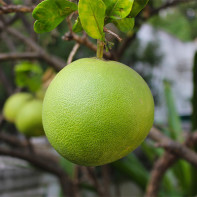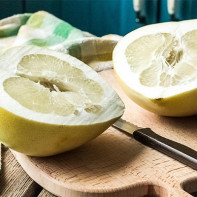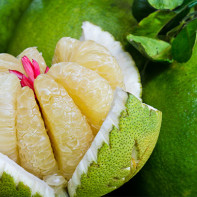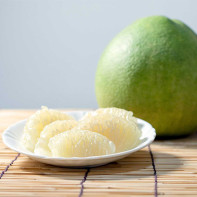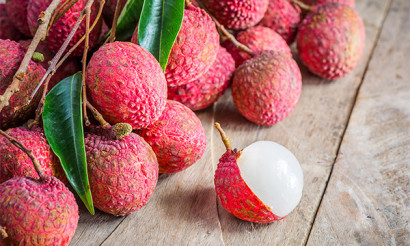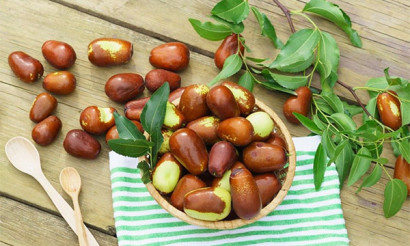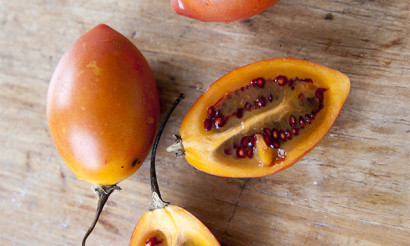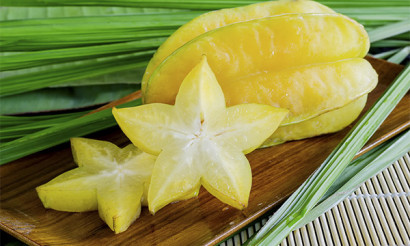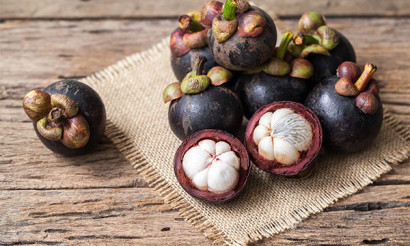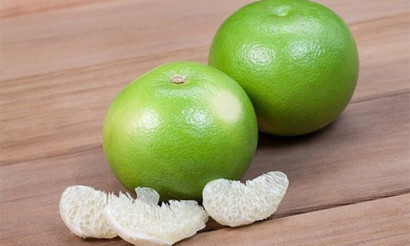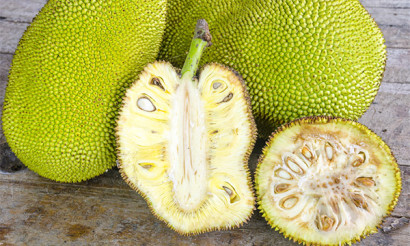Pomelo fruit: calories, beneficial properties and contraindications
Pomelo has been cultivated in Southeast Asia for more than 2000 years. The fruit originated in China and Malaysia, from where it spread throughout the region. Pomelo refers to the citrus fruit, it is often considered a hybrid of grapefruit, but this is a misconception.
- What is a pomelo and where does it grow
- Types
- What makes the pomelo different from grapefruit
- Composition and calories
- What is the usefulness of the pomelo
- For Women
- For men
- For Pregnancy
- For breastfeeding
- For Children
- The benefits of pomelo peels
- Useful properties of pomelo for weight loss
- Pomelo in medicine
- Diabetes
- For pancreatitis
- Gastritis
- For the bowel
- For constipation
- For gout
- For the liver
- For cholecystitis
- Recipes of traditional medicine based on the pomelo
- Dissolving and removal of kidney and gall bladder stones
- Strengthening the walls of blood vessels.
- Anemia
- Osteochondrosis Treatment
- Cough medicine
- Pomelo in cosmetology
- Rejuvenating mask
- Nourishing Mask
- Lotion for oily skin
- Hazards and Contraindications
- How to choose a ripe pomelo in a store
- How and where to store pomelo
- How to eat a pomelo fruit?
- How much can you eat per day?
- Eat it all night?
- Why are pomelos bitter?
- How to peel a pomelo quickly
- What can be cooked from a pomelo: Recipes
- Salad with pomelo and shrimp
- Jam
- Smoothie with Tangerine and Cashews
- Candied
- Can I Give Pets the Fruit of the Pomegranate?
- Interesting facts about the pomelo fruit
The fruit arrived in Europe twice. First it was brought by Dutch sailors, but the pomelo did not become popular. The second time it was brought from America by Captain Shaddock, hence its second name, shaddock.
What is a pomelo and where does it grow?
The fruit grows on the tree of the same name, which reaches a height of about 15 meters. The leaves are large and the flowers are white. Is the largest fruit of all citrus fruits, its mass can reach several kilograms, and in diameter and size it resembles a small melon. The taste is sour-sweet with a bitter undertone. The color of the fruit is from pale green to yellow, the skin is thick, the slices are large, separated from each other by a dense partition. To eat both raw and processed.
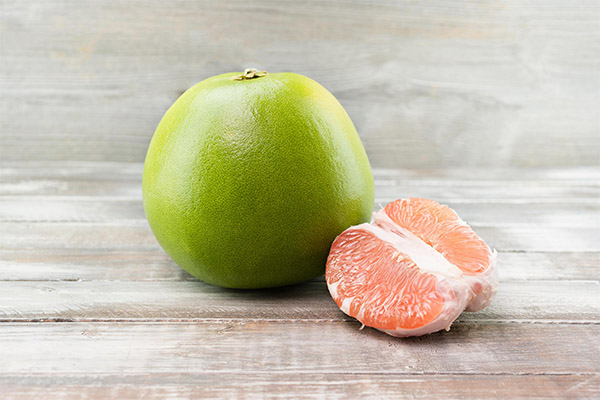
Types
Today, the pomelo is cultivated almost all over Southeast Asia, as well as in the U.S. (California) and Israel. There are more than 20 species, but only a few are considered popular:
- Khao-horn - sweet to the taste, light flesh, light green skin color.
- Khao namphung is shaped like a large pear, sweet to the taste, light colored flesh, and light yellow rind.
- Khao paen is the oldest type of pomelo, and has been grown primarily in Bangkok for more than 150 years. The fruit is slightly flattened, with a peel thickness of about 1 cm. The fruit has a peculiarity: the rind can be slightly wrinkled, and some people mistakenly think this is a sign of spoilage, but it is not. The flesh is quite large, consisting of ten or more wedges, and tastes sweet with a hint of bitterness.
- Khao phuang is a type of fruit that was bred early last century in the Philippines by the American explorer Wester. In fact, the pomelo was crossed with the mandarin. The fruit is shaped like a pear and has a peel about 2 cm thick. When ripe, its color turns greenish-yellow. The flesh consists of 12-14 slices. The fruit is juicy, sweet to the taste, no bitterness. The main supplier is Thailand, because this country has the most favorable conditions for its cultivation.
- Thongdi, a pomelo that was bred in Thailand, differs from all other species primarily by its size, reaching a diameter of 15 cm. The skin is greenish, about 1 cm thick, and the flesh is pink. It tastes sweet, without bitterness, with many pips. It grows well in conditions that are not suitable for the growth of citrus fruits.
What makes the pomelo different from the grapefruit
Grapefruit came from the accidental hybridization of a pomelo and an orange, so it is a hybrid of a pomelo, not the other way around. The grapefruit gets its name because its fruit resembles bunches of grapes.
Of course, the fruits are quite similar, but they differ both in taste and shape, as well as in the content of useful elements.
Composition and calories
First of all, it is important to note that 100 grams of the fruit contains about 35-40 kcal, which is why pomelo is considered a diet product. And most nutritionists include it in their diets.
100 g contains:
- Protein - 0.7-0.9 g.
- Fats - none.
- Carbohydrates - about 9 g.
- Dietary fiber - about 1 g.
In addition to low calories, pomelo differs from many fruits in the content of vitamins, micro- and macronutrients.
Vitamins
Most of all it contains B vitamins, namely:
- Vitamin B1 - plays a huge role in the metabolic process. Vital for normal development and growth. It has a positive effect on the heart and nervous system, and normalizes the processes of the gastrointestinal tract. Most people need additional intake of this vitamin, especially those who consume mostly cooked food, alcohol and tea.
- Vitamin B2 is one of the most important water-soluble vitamins because it is necessary for the formation of red blood cells and antibodies in the blood. It also regulates and normalizes reproductive function. It has a positive effect on the growth of hair, nails and body health.
- Vitamin B6 - plays a direct role in regulating the assimilation of proteins by the body. It is necessary for the production of blood cells and hemoglobin.
Also the pomelo has in its arsenal of vitamins:
- Vitamin C is perhaps one of the most important and necessary vitamins in the human body and is the most powerful antioxidant. It participates in the formation of DNA and is necessary for the normal functioning of connective and bone tissue.
- Vitamin RR or nicotinic acid - refers to B vitamins, is needed in the body to participate in oxidative processes. It is also sometimes called the "serenity vitamin" and is compared to vitamin C.
- It is worth highlighting vitamin A separately. Pomelo contains beta-carotene, which under the action of certain enzymes becomes vitamin A. If we talk about taking pills, in most cases it is possible to overdose on the vitamin, so it is better to consume foods containing beta-carotene.
Macronutrients
- Calcium is an element that is necessary for the formation and renewal of bone tissue. Also in combination with sodium supports the function of intercellular membranes.
- Magnesium - an element that many scientists call "the metal of life" because it is involved in almost all processes related to metabolism in the body and supports the health of all cells.
- Sodium is found in one form or another in every human organ. From this we can conclude that its deficiency can affect the normal development of the body.
- Potassium - the element responsible for metabolism between cells. Decreased potassium in the body can not be recognized immediately, which poses a certain threat. One of the signs of decreased amounts are spasms and pain, as it affects the "strength" of the muscles. Lack of this element makes the blood vessels thinner, which leads to high blood pressure.
- Another important beneficial macronutrient found in the composition of the pomelo is phosphorus. Although its main amount is found in the teeth and bones, we can safely say that it is important for the whole body, because it is directly involved in the formation of cell membranes.
Micronutrients
- Iron. The main function of this element is the delivery of oxygen to all cells in the body. It is iron that is responsible for oxygen uptake and then red blood cells can distribute it to all organs. Also it takes a direct part in metabolism, because iron is a part of many proteins and enzymes.
- Zinc. This element is no less important than the others. A person must consume a sufficient amount of it because it participates in metabolism and helps to strengthen bones and teeth. Zinc is also necessary for the synthesis and breakdown of almost all proteins.
- Copper. Thanks to it, iron in the body becomes hemoglobin, and also takes part in the formation of some enzymes.
What is the use of pomelo
In addition to the useful elements already listed, the fruit of the pomelo contains others that have a positive effect on the human body as a whole, and in some cases can be especially valuable specifically for a woman, a man or a child.
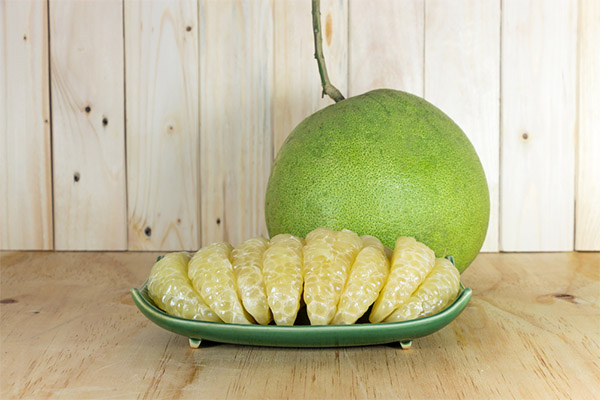
For women
The fruit contains essential oils and flavinoids, which contribute to the normal functioning of the pancreas and hinder the development of breast cancer cells. They also alleviate post-operative conditions and the effects of chemotherapy.
In menopausal women, hormones are disrupted, which leads to osteoporosis. Pomelo helps to remove excess estrogen from the body and thus participates in the normalization of hormonal background. And phosphorus and calcium in its composition prevent the development of osteoporosis and strengthen bone tissue. Thus, in some cases, the fruit is a must for women of a certain age.
Pomelo is also used for cosmetic purposes, it smoothes wrinkles and improves the complexion. Its juice can be used to wash and prepare masks.
For men
Antioxidants contained in the pomelo are able to remove poisons and toxins from the body, so the fruit should be used after a hangover.
This is the most important part of the fruit, because it has essential oils, which make the pomelo a powerful aphrodisiac, which greatly increases the sex drive in men. And the presence of vitamin C strengthens vascular walls and improves blood circulation in the pelvis, which increases erectile function.
When pregnant
Pomelo contains many nutrients, which makes it an excellent fruit for the diet of expectant mothers. First of all, it is vitamin C, which protects the immune system of the mother, and therefore the baby. The fruit can be eaten both in the first trimester, and much later.
Due to the presence of phosphorus and calcium, the pomelo not only strengthens the mother's bone tissue, but also contributes to the normal development of the fetal skeleton. A significant useful property is the reduction of blood pressure, which is often elevated in pregnant women.
The fruit can and should be eaten by those pregnant women who suffer from gastrointestinal problems. It normalizes bowel function, stops heartburn and belching. It also improves mood and helps fight depression.
When breastfeeding
Breastfeeding is a period that is extremely important for any baby in the first six months of life. It is the mother's milk that protects it from viruses and infections. That is why it is so important to follow a certain diet at this time.
Most experts do not recommend limiting the intake of healthy foods, because what is good for the mother's body is also good for the baby. However, in the case of the pomelo, as well as most citrus fruits, there is a caveat. It is no secret that even ordinary food can cause an allergic reaction, not to mention such fruits as mandarins, oranges and pomelo. You need to use them with caution. If mom wants to introduce them into the diet, you should do it gradually.
For children
Children can be given the fruit from the age of two, as at an early age it can cause allergies. Pomelo can be eaten by a child not more than 2-3 times a week, because the fruit significantly affects digestion. In children, with frequent use, it can cause gastrointestinal disorders.
In general, the fruit is very useful for children because it contains large amounts of vitamin C, which strengthens the immune system. In combination with other drugs, pomelo is used to treat anemia due to the presence of iron in it.
More useful properties of the pomelo for children:
- Thanks to the presence of phosphorus, the pomelo improves the intellectual potential of the child.
- If you regularly consume the fruit, there is a normalization of blood pressure.
- Limonoids prevent the development of cancer cells, so it is included in the diet of children who are prone to cancer.
- Thanks to iron, zinc and magnesium, the pomelo increases metabolism, which leads to the release of energy, which is so necessary for children who are actively involved in sports.
- Pectin normalizes and improves gastrointestinal function.
The benefits of pomelo peels
The beautiful and bright peel of the pomelo smells nice and contains beneficial bioflavanoids and vitamin PP, which is beneficial for the health of the gastrointestinal tract. In particular, it prevents diseases associated with it. You can't eat the peel because it is inedible and bitter. But it can be added to tea or make jam from it.
Useful properties of pomelo for weight loss
As mentioned earlier, many experts include the pomelo in the composition of diets for weight loss. The importance of this product is due to the fact that due to the presence of fiber in the composition of the fruit causes a feeling of satiety, and vitamins and useful substances compensate for their lack in the diet.
The fruit itself has a fairly low caloric content, and a large number of macro-and micronutrients involved in assimilation and metabolism, improves the metabolism and causes the breakdown of fat, respectively, contributes to weight loss. The normalization of the gastrointestinal tract also contributes to weight loss and overall health.
Specialists recommend using pomelo in mono diets and including it in your diet on days of detoxification.
Pomelo in medicine
In diabetes.
One of the few products that are allowed to suffer from type 1 and type 2 diabetes is the pomelo. Its glycemic index is 30, which is normal for patients with this pathology.
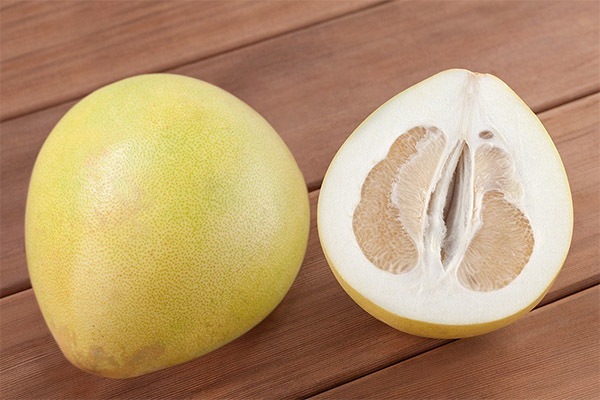
The fruit is low-calorie, so you should not worry about the figure. He saturates the body with useful substances, which is extremely important for diabetics. It also reduces the amount of glucose in the blood and prevents its surges.
Pomelo has a beneficial effect on the pancreas, whose malfunction is a problem for all diabetics, and the essential oils in its composition help to carry various infectious diseases easier. Pomelo can cause harm only to those who have an individual intolerance, all others can and should use it.
As for the amount of fruit that can be consumed with the disease, it is no more than 150 g, so the fruit should be divided into several parts. Pomelo juice can be drunk not more than 100 ml at a time.
With pancreatitis
The peculiarity of the diet with pancreatitis is that in the first period of the disease or at its exacerbation, it is strongly not desirable to eat fresh products. Over time, this prohibition is partially removed. If we talk specifically about the pomelo, its use in pancreatitis is highly discouraged.
The organic acids contained in the pomelo activate the stomach. They are also activators of the glands responsible for the production of enzymes that contribute to accelerated digestion, which is not recommended in this disease.
It is worth remembering that over time, with proper treatment, many fruits and vegetables can be returned to the diet. However, you need to be careful not to be at the very beginning of the treatment path of the disease.
Gastritis
Gastritis is a disease that occurs when the stomach acidity is low, high and sometimes normal. If you have elevated acidity, eating pomelo is strongly discouraged. It contains a large amount of organic acids, which have a negative effect on the already inflamed mucosa of the stomach.
At the same time, with reduced acidity eating the fruit in limited quantities is possible. In this case, the increase in acidity will be not to the detriment, but for the benefit. Especially since the same organic acids in the composition of the fruit will promote motility and improve digestion. Thus, there is no unambiguous answer to the question - whether the product is useful or harmful for gastritis. In any case, if you include this product in the diet of patients with this ailment, you should consult a doctor and take a number of tests.
For the intestines
As mentioned above, the pomelo directly affects the gastrointestinal function because of the presence in its composition of a large number of organic acids, as well as specific fiber, which is different from other citrus fruits. This contributes to the removal of toxins and detoxes. And if you eat pomelo regularly, digestion and motility of the stomach improves.
For constipation
The breakdown of complex proteins can cause GI disorders and problems. Pomelo contains about 1/4 of the daily allowance of fiber, which normalizes digestion and prevents the occurrence of constipation and diarrhea. It also stimulates the production of enzymes that promote the active breakdown of food, which facilitates the digestion of proteins, fats and carbohydrates.
Gout
Gout is a disease associated with an accumulation of uric acid salts in the joints. In this disease, in addition to medication, a certain diet must be followed in order to overcome the disease. In gout, you can eat pomelo, as well as other citrus fruits, but before this you should consult with a supervising specialist. The presence of vitamin C and organic acids has no effect on the deposition of salts in the joints.
In order to properly compose a diet for gout, you should know that the consumption of products containing purine and uric acid is not recommended. Even in the case of inflammation, pomelo and some other fruits can be eaten without fear of aggravation.
Vitamin C, which is found in large quantities in the pomelo, is very important in the fight against gout. It slows the aging of the cells of the bone and connective tissues, and the combined effect with some drugs only enhances the effect of the latter. The vitamin also speeds up and facilitates the elimination of urates from the patient's body.
For the liver
For the liver are useful products containing mainly vitamins A and C, so that the pomelo not only does not harm its work and condition, but on the contrary, it is very useful. In addition, the presence of elements such as magnesium and potassium only increases the usefulness of the fruit.
For cholelithiasis
Just like with pancreatitis and diabetes, with cholecystitis you need to follow some diet. Together with the drugs taken, the fruit helps to establish the normal functioning of the gallbladder.
To improve the work of the stomach, in particular peristalsis, and to conduct bile, most nutritionists and doctors recommend consuming sweet fruits.
Pomelo, which is rich in vitamins, dietary fiber, macro- and micronutrients, is just right for the diet of patients with cholecystitis. In addition, beneficial substances of pomelo stimulate the secretion of bile and digestive glands, reducing cholesterol levels and eliminating constipation. And vitamin C prevents the thickening of bile, and therefore the formation of gallstones in the gallbladder.
Recipes of traditional medicine based on the pomelo
Dissolution and excretion of kidney and gallbladder stones
To begin with, in one day you should completely refuse to eat, you can drink water in unlimited quantities. Before starting the procedure, it is best to do a cleansing enema, and an hour later drink a glass of olive oil and 200 ml of pomelo juice. After drinking olive oil, nausea may occur, so it is better to lie down immediately. After about half an hour you should take a salt laxative. The next day the procedure should be repeated.
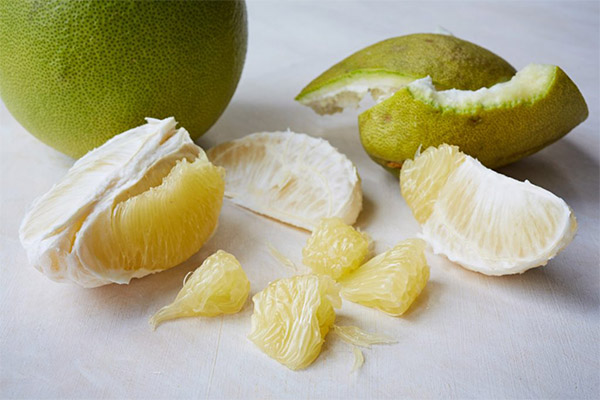
The exit of the stones can be seen in the urine in the form of small granules. The procedure should be repeated until the sand stops coming out. It may take about a week, but the result is worth it. An ultrasound scan can be done before and after the procedure to see how effective it is.
Strengthening the walls of blood vessels
Pomelo peel contains vitamin PP, which contributes to the strength and elasticity of blood vessels, and this ensures the transfer of ascorbic acid and affects the amount of cholesterol in the body. Vitamin PP is water-soluble, so it is quite easy to isolate. To do this, the diced peel should be placed in boiling water for one hour. Then the resulting solution should be drunk, and the peel should be eaten.
Anemia
Anemia results in a lack of iron in the human body. The ailment is treated quite simply - with mixtures of juices from fruits and vegetables: grapefruit, pomelo, apple or carrots. The amount of a particular juice, as well as the composition can be changed periodically.
Treatment of osteochondrosis
Water-salt balance is important for the normal functioning of organs when it is disturbed. Osteochondrosis, gout or arthritis occur because of the lack of necessary elements, in particular sodium.
Folk remedy is not a cure, but it can be used together with the main drug to increase the effectiveness of treatment. The essence is as follows: you need to chew the crust of the pomelo for a few minutes, and then swallow it. Do it once a day. After 10 procedures, you can evaluate the result.
When treating a cough
Means pretty easy to prepare, you need: 0.5 kg of pomelo, 0.25 ml of honey and 0.1 liter of vodka. The pulp of the melon to grind in a bowl, pour the vodka and leave to infuse for 24 hours.
Then heat the container in a water bath until the vodka completely evaporates. The resulting mass pour honey. Take three times a day with one tablespoon.
Pomelo in cosmetology
Rejuvenating mask
To prepare a rejuvenating mask, you need to take 100 grams of fruit pulp, the same amount of honey and 50 grams of lemon juice. First you need to carefully peel the pulp of the pomelo and grind it into a puree, which is mixed with honey, and then add the lemon juice. The mask should be applied to the face and leave for 20-25 minutes, then rinse with warm mineral water. Do not wipe with a towel after the procedure. After drying the skin is possible to apply a moisturizing cream.
Nourishing mask
To prepare the mask you need to take 100 grams of pomelo pulp, a tablespoon of honey and lemon juice. Peel and grind the pulp, add honey and lemon juice and mix thoroughly. Apply before sleep, except for areas around the eyes, for 10-15 minutes, then rinse with water. The skin after such a mask will be soft, the complexion will be even, inflammation will disappear, pores will become clearer.
Lotion for oily skin
To make the lotion you will need vodka and the actual pulp of the pomelo. The latter must be peeled and cut into slices. Then put it in a shallow bowl and pour the vodka, which should cover the fruit by 2 cm. Insist 2 weeks, stirring occasionally. After that, strain, dilute the resulting liquid with boiled water 1:1.
The damage and contraindications.
Have pomelo has no contraindications, but it is not recommended to use, if there are kidney or liver problems, compromised stomach acidity, as well as personal intolerance.
If too much is consumed, dizziness, nausea, constipation or diarrhea may occur.
How to choose a ripe pomelo in the store
The pomelo is harvested unripe for export. The ripening process takes place on the road and at the store shelves, so you need to know how to choose the right fruit so you are not disappointed in your purchase.
- The first thing you should pay attention to is the color of the fruit, it must match the variety.
- Secondly, the fruit should be soft and have a pleasant characteristic flavor.
- Third, it should be the right size for its weight. For example, sometimes a fairly large pomelo can be light, which means that it has not gained enough moisture, which means that the pulp has no taste and nutritional value.
- One last thing: The fruit should have no damage, dents or signs of decay.
How and where to store the pomelo correctly
Few people know how to correctly and where to store the pomelo, this is due to the small popularity of the fruit. The shelf life depends directly on the species. If you choose the right fruit when buying, it can be stored for up to 8 weeks.
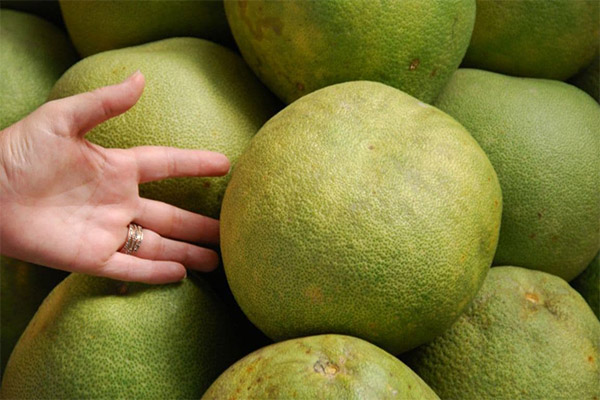
So, the pomelo, like any citrus fruit, likes dark and cool places, the ideal temperature for this is +5 ° C. In these conditions, it will be stored for 7 to 8 weeks. If the fruit is kept indoors at room temperature and exposed to sunlight, the period is reduced to 3-4 weeks.
Unripe fruit should not be placed in the refrigerator or cool place, as under these conditions they will not become ripe. It is better to store such fruit at room temperature. Signs of immaturity are an irregular coloring of the fruit and the lack of a characteristic smell.
In the refrigerator, the pomelo should be stored so that the fruits are not in contact with each other and wrapped in clingfilm. If one begins to spoil, it should be removed from the others.
The peeled fruit should not be kept even in the refrigerator for more than a day.
How to eat the pomelo fruit correctly
How much you can eat in a day
Since the pomelo significantly affects the function of the stomach, you should not abuse this product. The optimal daily rate should be half of the fruit.
Can I eat at night
Due to the fact that the fruit quickly dulls hunger, as well as low-calorie and not overloading the body, it can be eaten at any time, including at night.
Why are pomelos bitter?
Sometimes a pomelo is slightly bitter, and this is quite normal. However, the bitterness should not be as pronounced as that of grapefruit. If the fruit is obviously bitter, this means that it is overripe or has been frozen. This happens because the pomelo is shipped while still green, and it can become overripe on the road.
How to peel a pomelo quickly
Those with strong fingers and nails can peel the fruit without tools, everyone else will need a small knife. To begin, the pomelo needs to be washed and dried.
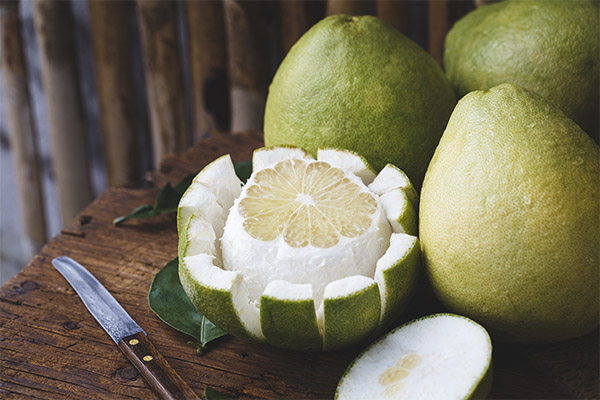
To quickly and properly peel the fruit, first you need to cut off the top. Then a few cuts should be made in a downward direction, gently pick up the skin and separate it from the pulp. If the fruit is ripe, this will not be too difficult.
What you can make with the pomelo: Recipes
Salad with pomelo and shrimp
Seafood has always been combined with citrus fruits, and the pomelo is no exception.
To prepare the salad you will need:
- 1 small pomelo.
- 200 g shrimp.
- Salt to taste.
- Half a lemon.
- A teaspoon of honey.
- Lettuce.
- Red peppers.
- Rucola, pomegranate seeds.
The preparation of the salad is very simple: to do this, boil the shrimp, peel and cool. Then carefully peel the pomelo and cut the slices into 2-3 pieces. For dressing, you need to mix salt, honey, lemon juice, olive oil and pepper. Mix shrimp, sliced pomelo and dressing, add arugula and salad, serve the dish with a sprinkling of pomegranate seeds.
Jam
To make the jam you need pomelo, sugar and lemon juice. You can add nutmeg or cloves.
The pomelo must be thoroughly peeled, for 1 kg of pulp you need 700-800 grams of sugar. Fill pulp with sugar, add lemon juice (100 ml) and leave for 6-7 hours. Then put on the fire and bring to a boil, cool and cook over low heat for about 5-7 minutes. Since the pulp is somewhat drier than other citrus fruits, the jam is much thicker.
Smoothie of pomelo with tangerine and cashews
Smoothies, unlike juices, are healthier because they retain fiber, which does not raise blood sugar.
You will need: 200 grams of pomelo pulp, 4 small tangerines and 20 grams of cashew nuts.
You need to carefully peel the pomelo and tangerines from the peel and seeds. Cut the flesh of the pomelo into small pieces. In a blender initially put the nuts. After they are crushed into powder, add the prepared fruit. Whip the fruit with the nuts for 3-4 minutes. A healthy pomelo smoothie is ready.
Candied fruits
There is also nothing difficult in the preparation of candied pomelo. You will need pomelo peels, water, sugar and patience.
First, you need to cut the peel of the fruit and soak it in water for two days. The water should be refreshed twice a day, so that the bitter taste is gone from it. Then drain it and add fresh water, put on the fire and bring to a boil. This procedure should be repeated 4-7 times, until the rind becomes transparent. Now you need to fill the peels with sugar and add water, so that it slightly covers them. Again put on the fire and cook for 30-40 minutes. Once the pomelo peel bars have cooled to room temperature, lay them out on parchment paper and dry them. The drying process can take several days.
Can we give pets the pomelo fruit?
There is a widespread belief that animals should not be fed foods that are not in their natural habitat. But it is safe to say that an animal will not eat anything that is harmful to it. As for citrus fruits, namely the pomelo, eating them in animals poses no threat, on the contrary, the useful substances and elements will only benefit.
You should not feed your pet a pomelo if it has a digestive system disorder, diabetes or personal intolerance to the fruit.
It is also believed that citrus fruits are dangerous for animals because of the high amount of vitamin C. This judgment is fundamentally wrong, if there are no problems with the kidneys and liver, the excess vitamin is eliminated from the animal's body without problems.
Interesting facts about the pomelo fruit
- The pomelo is the largest citrus fruit.
- The pomelo is sold wrapped in a film that protects it from mold and fungus.
- The flesh of the pomelo is drier than that of other citrus fruits, so making juice from it is impractical.
- The fruit can weigh up to 10 kg and its peel can be 5 cm thick.
- People in China still give pomelos for New Year's Eve.
- The heavier the fruit, the more delicious and nutritious it is.
«Important: All information on this site is provided for informational purposes only. for informational purposes only. Consult a health care professional before applying any recommendations. specialist before using any of the recommendations. Neither the editors nor the authors shall be liable for any possible harm caused by materials."

